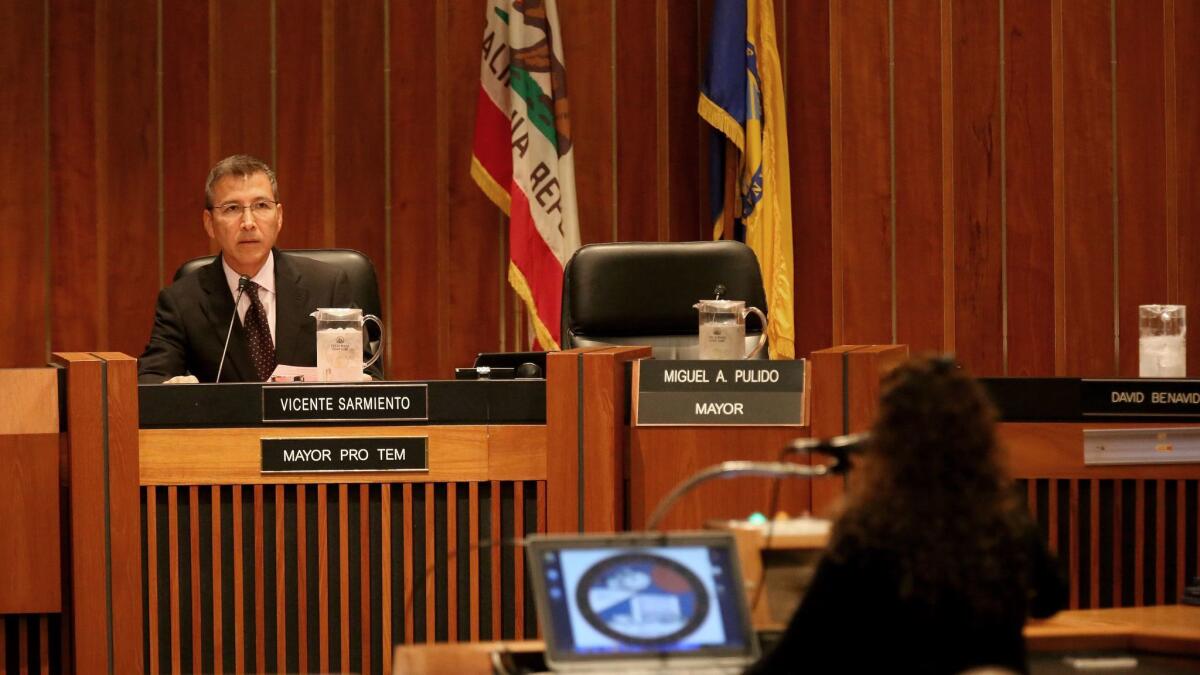Santa Ana declares itself a sanctuary city in defiance of Trump
Since Donald Trump was elected president in November, cities with large Latino populations have debated how to respond.
Many activists have urged these communities to do everything they can to protect people in this country illegally, even though such efforts might jeopardize some federal funding from a Washington in which Republicans will control not only the White House but also Congress.
Santa Ana — the seat of Orange County and home to one of the nation’s largest Latino populations — decided this week to strike a defiant tone.
City Council members voted to declare Orange County’s second-most populous city a sanctuary city — a largely symbolic gesture to protect immigrants who are in the country illegally.
Tuesday’s vote is historic in that it makes Santa Ana the first city in Orange County to grant itself the designation. It joins dozens of other cities across the country that have declared themselves sanctuaries.
For most, like Santa Ana, the move is largely a message of political support for immigrants in the country illegally. But some cities have specific policies tied to them, notably San Francisco, which has come under criticism from Trump.
“The day after Donald Trump got elected, our kids were falling apart emotionally. They thought their parents would be deported,” said Sal Tinajero, a City Council member and teacher at Fullerton Union High School.
“The reason you’re seeing this push now is that us leaders ... want to tell them they are going to be protected. If they are going to come for them, they have to come through us first.”
Although city officials said they were sending a strong message to the community and to Trump, the move essentially maintains the status quo. The resolution is nonbinding and doesn’t add policies to provide additional protections to people who are in the country without legal status.
Council members, however, expressed support for making the resolution into an ordinance after dozens of community organizers urged them to do so during Tuesday’s meeting. The ordinance may come up for a vote at the council’s next meeting.
In addition, the council also voted to modify the resolution to establish an oversight committee or task force to oversee its implementation.
Immigrant rights activists urged the council to prohibit the city from sharing information about people without legal status with federal officials.
“I want to ensure that these protections are meaningful and not just symbolic,” said Carlos Perea, a Santa Ana resident and member of a grass-roots immigrant rights group called RAIZ.
Councilwoman Angelica Amezcua agreed.
“I think it’s time to take action,” she said. “This is just symbolic gesture. We need to move forward with an ordinance as well.”

But Robin Hvidston, president of We the People Rising, a Claremont organization with members in Orange County who lobby against illegal immigration, criticized Santa Ana’s decision.
“It is very sad that the city is not focusing upon the suffering American citizens — such as the homeless families and unemployed American citizens in Santa Ana — instead of promoting the breaking of federal immigration laws,” Hvidston said in a statement.
“The resolution invites federal lawbreakers worldwide to settle in Santa Ana.”
Mayor Miguel Pulido and Councilwoman Michele Martinez were absent from the meeting.
Also Tuesday, the council voted to notify Immigration and Customs Enforcement officials that the city plans to reduce the number of beds available in its jail to house immigration detainees from about 200 to a maximum of 128.
The move is part of a plan to phase out an agreement with Immigration and Customs Enforcement after council members voted in May to terminate the contract as soon as possible.
Although immigrant rights activists applauded the council’s decisions, they said city officials didn’t go far enough and urged them to create a specific timeline when they will terminate the agreement with ICE.
“We believe a sanctuary city with an immigration detention facility is contradictory…. The city will only truly be a sanctuary city when it ends its contract with ICE,” said Christina M. Fialho, a Costa Mesa attorney and executive director of Community Initiatives for Visiting Immigrants in Confinement, a national group that coordinates jailhouse visits with immigrants in detention.
Scaling back the city’s contract with ICE also means shutting down one housing module and a $663,743 loss in annual revenue.
Immigration and Customs Enforcement spokeswoman Virginia Kice said the agency was aware of the vote. She said that Santa Ana Jail is the smallest contract detention facility utilized by ICE in the Los Angeles area and that ICE is prepared to adjust to the change.
Kice said the agency would try to continue to collaborate with law enforcement agencies, such as Santa Ana Police Department.
Trump made illegal immigration a central issue of his presidential campaign, vowing to build a wall along the U.S.-Mexico border, deport people who are in the country illegally and unwind immigration relief created under President Obama.
During the campaign, Trump said he also would withhold federal funds to punish so-called sanctuary cities, including Los Angeles and Chicago, for their lenient policies toward illegal immigration.
But the terms of a sanctuary city are loosely defined and vary depending on jurisdictions. Some communities — such as Santa Ana — make resolutions that are mostly symbolic while others vote in ordinances that cut ties with federal immigration officials.
Community organizers had hoped for an ordinance — not a resolution — that were more in line with larger cities, such as San Francisco, Los Angeles and New York. For instance, San Francisco adopted far-reaching policies, such as taking steps to cut ties with federal immigration officials and refusing to fully cooperate with them.
San Francisco declared itself a sanctuary city in 1989, and city officials strengthened the stance in 2013 with its “Due Process for All” ordinance. The law declared local authorities could not hold immigrants for immigration officials if the immigrants had no violent felonies on their records and did not currently face charges.
That city entered the national debate over immigration this summer, when Kathryn Steinle was fatally shot by Mexican national Juan Francisco Lopez-Sanchez in the Embarcadero neighborhood.
Lopez-Sanchez had been deported five times before he shot Steinle. Trump described the murder as “a senseless and totally preventable violent act committed by an illegal immigrant.”
Councilman Tinajero said Santa Ana has already adopted policies that help protect people who are in the country without legal status. He said he understands that the resolution may make Santa Ana a target for Trump, but says the city is in a strong enough financially to confront what may come.
“This is a time of crisis,” he said. “And we’re prepared for it.”
Follow Cindy Carcamo on Twitter @thecindycarcamo
ALSO
Trump’s crackdown on illegal immigration leaves a lot unanswered for sanctuary cities like L.A.
LAPD will not help deport immigrants under Trump, chief says
When Trump says he wants to deport criminals, he means something starkly different than Obama
UPDATES:
10:15 p.m.: This article was updated with a comment from a critic of Santa Ana’s resolution.
This article was originally published at 9:25 p.m.
More to Read
Start your day right
Sign up for Essential California for news, features and recommendations from the L.A. Times and beyond in your inbox six days a week.
You may occasionally receive promotional content from the Los Angeles Times.







